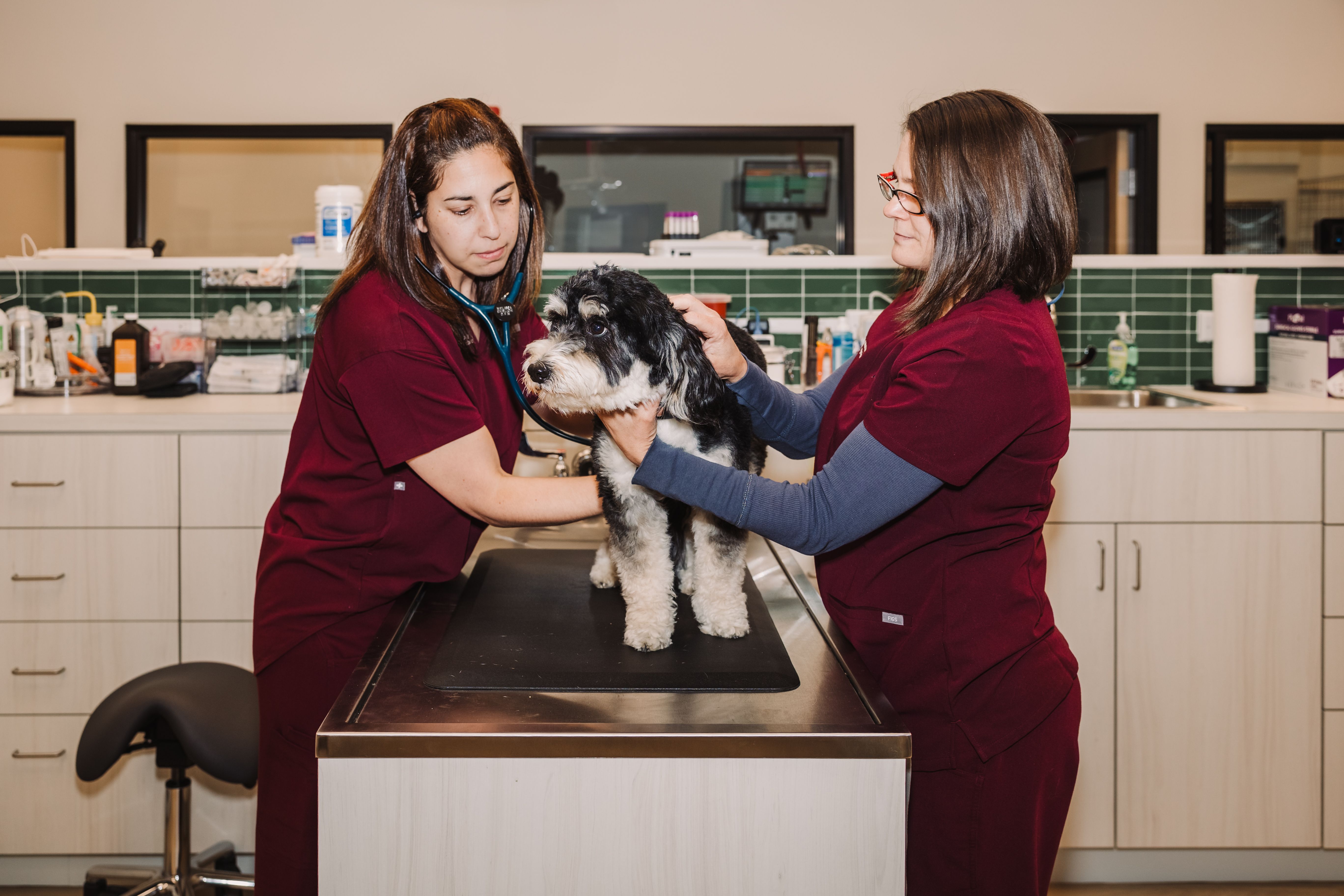As an emergency room vet, one of the key parts of my exam is figuring out if a pet is in pain. This can be tricky because, unlike humans, our patients can’t tell us what’s wrong. In human medicine, you can simply say where it hurts or point to the problem area. Even in pediatrics, kids can use a chart with smiley faces to show how they’re feeling. So, how do we, as vets, figure out if an animal is in pain?
While our pets may not use words to describe how they’re feeling, changes in their behavior, posture, or overall routine can be the first indication that they are experiencing discomfort or pain. Some signs of pain in animals can be quite subtle, as their natural instinct is to hide or mask discomfort. However, a trained eye can pick up on the clues.
Signs of Pain In Your Pet
Here are the signs I would watch for:
- Physical signs: Limping, stiffness, swelling, redness, warmth in a specific area, guarding a body part, difficulty getting up or lying down
- Behavioral changes: Whining, yelping, growling, excessive vocalization, decreased activity, hiding, becoming withdrawn, less social interaction, or uncharacteristic aggression/guarding behavior
- Grooming habits: Excessive licking or scratching a specific area
- Eating and drinking habits: Decreased appetite or thirst
- Postural changes: Hunched back, flattened ears, low posture
- Facial expressions: Grimacing, glazed eyes, wide pupils
Here are some questions you can ask yourself to help determine if your pet might be in pain:
- Do certain behaviors become more apparent after exercise?
- Are behaviors more pronounced in the morning or evening?
- Is my pet less willing to go up or down stairs or jump on and off furniture?
When Should I See a Vet?
If you've determined or suspect that your pet is in pain, it’s time to visit your veterinarian. They will conduct a thorough physical examination, which includes both orthopedic and neurologic assessments. These exams help confirm your pet’s discomfort, pinpoint the location of the pain, and identify its underlying cause.
How Can You Help a Pet In Pain?
Treating pain in pets focuses on addressing the underlying cause and can involve a range of approaches, from exercise restriction and cage rest to medication or even surgery, depending on the diagnosis.
What Can I Do For My Pet Until I Can See the Vet?
While you’re waiting to visit the vet, here are a few things you can do at home to help manage your pet’s symptoms:
- Ice Therapy: Ice is good for aches related to bone and joint issues as well as newer injuries. Use a cold towel or frozen item covered in a dry towel on the affected area for 10 to 20 minutes at a time. Ice should not be applied directly to the skin and the area should be monitored closely to avoid cold-induced injury. Ice is best within the first 24 hours to help keep the swelling, pain, and inflammation down.
- Heat Therapy: Heat can help relieve chronic pain or pain related to an injury that is more than 72 hours old. Use a warm towel or a heated blanket on the affected area for 10-20 minutes. Again, check the heated item on the back of your wrist to confirm it’s not too hot to avoid thermal injury and always make sure to supervise your pet.
- Environmental Modifications: Pets in pain may struggle with walking on slick surfaces, leaning down to eat, or using stairs. Adding rugs or carpets to wooden floors can improve traction and make movement easier. Raising food and water bowls can help reduce neck or back strain during meals. To support rest and recovery, limit your pet's access to stairs and keep them on a leash when going outside to control their activity levels.
Can I Give My Pets OTC Human Medications?
The short answer is no. The longer explanation is that most over-the-counter human pain medications like Aleve (naproxen sodium), Advil (ibuprofen), Aspirin, and Tylenol (acetaminophen) are extremely toxic to both cats and dogs because of differences in metabolism versus humans. While aspirin has a margin of safety for use in dogs, it’s not as effective for pain relief as veterinary-prescribed nonsteroidal anti-inflammatory drugs (NSAIDs). Naproxen and ibuprofen both can cause serious toxic effects including GI upset and ulcer formation, kidney failure, liver failure, and central nervous system effects. Acetaminophen in cats causes lethal changes to their red blood cells.
It's crucial to follow your veterinarian's instructions carefully when giving any medication, as an NSAID overdose can cause serious complications like gastric ulcers or organ failure, which can be life-threatening if not treated promptly.
What Other Pain Management Techniques Are Available?
Besides veterinary-prescribed nonsteroidal anti-inflammatory medications, both acute and chronic pain can be alleviated by additional methods:
- Steroid medications such as prednisone are used to reduce inflammation and are often prescribed short-term with a tapering dose. This group of medications is commonly used for allergic reactions such as swelling from a bee sting but may also be prescribed for other painful inflammatory conditions including back pain or cancer-associated pain. Steroids typically have more side effects than NSAIDs, and the two are never prescribed together. Side effects, including increased thirst, hunger, urination, and panting, should subside once the medication course is completed.
- Narcotic medications are typically used in the hospital under the supervision of a veterinarian due to the high potential for dependence or abuse by humans. If these medications are prescribed for at-home use, it is usually for short-term use to alleviate acute pain or coughing or to provide mild sedation prior to a medical procedure.
- Muscle relaxant and nerve pain medications are often prescribed for patients who are experiencing back pain, neck pain, or other chronic painful conditions such as osteoarthritis that may cause muscle spasms.
- Joint supplements and nutraceuticals such as glucosamine and chondroitin sulfate are often used in dogs and cats with osteoarthritis. These products help support the joints and indirectly have an anti-inflammatory effect, helping to alleviate pain.
- Nutrition is essential in the management of osteoarthritis. Weight loss in overweight dogs with osteoarthritis has been proven to contribute significantly to pain relief. To help your pet lose weight, consult your primary care veterinarian to develop an appropriate nutrition plan. Simply reducing the portion of regular maintenance food can lead to malnourishment. Once an ideal body condition has been achieved, it’s important to maintain a nutrient profile that has been proven to help manage osteoarthritis. Diets containing omega-3 fatty acids have been shown to reduce inflammation.
- Physical medicine refers to therapies that involve directly treating tissues with hands-on techniques. Examples include acupuncture, trigger point release, and chiropractic adjustments, which may be recommended and performed under the supervision of a veterinarian trained in these methods. Physical therapy/rehabilitation encompasses a broad scope of physical medicine that includes therapeutic laser therapy, joint mobilization, medical massage, stretching, therapeutic exercise, and hydrotherapy.
Multimodal therapy, which combines several of the above approaches, is often the most effective option. Each treatment plan is tailored to the specific needs of the patient and adjusted as progress is made. This approach recognizes that pain is a complex condition requiring a comprehensive strategy, and by combining modalities, the treatments work synergistically to provide better results than any single method could achieve on its own.
Pets experience pain just like humans do. And while their pain may be acute or chronic, it’s imperative that we, as their advocates, recognize when they’re not feeling well. With early detection, we can promptly seek veterinary attention, alleviate suffering, and prevent the progression of underlying health issues. If you believe your pet is in pain, Ruby Veterinary Urgent Care is available to help provide that relief. We recognize the importance of promptly and effectively managing your pet's pain. Our knowledgeable and highly experienced team is committed to delivering the highest level of care to ensure your pet's comfort and well-being.











